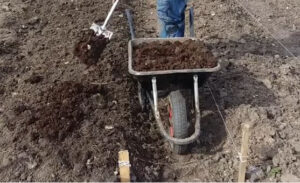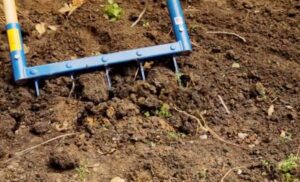In this article, we are going to be looking at a step by step guide on how to prepare a garden plot for planting flowers and vegetables.
Short answer: To prepare a garden plot, select your garden spot. Then mark the boundaries and remove all weeds and other off-plants within the boundaries to eliminate competition. Add both organic and inorganic fertilizers. And then, turn the soil to make sure everything is evenly distributed.
Beginner to gardening? Read our step by step guide to starting a new garden
Read on for a step by step guide on how to clear a garden spot.
But, before preparing a garden plot, you need to be familiar with some of the different garden layouts and designs so that you can pick one that suits your dream garden.
Below are the common garden layout designs you can choose for your garden:
- Four square
- Block
- Raw
- Square foot
Four Square
This is a vegetable garden layout where the garden plot is divided into four square beds. In this case, each square within the main square represents a garden bed.
This type of garden layout is usually adopted when you want to grow four different garden plants with different soil nutrient requirements.
The plants can be categorized as follow:
Heavy Feeders: these include plants that require more nutrients and they are planted in the first square. Examples are corn and leafy green vegetables.
Middle Feeders: the second category is called middle feeders. They do not require nutrients like heavy feeders but they also like to be supplemented regularly. Examples include tomatoes and peppers.
Light Feeders: these plants are planted in the third square. They require a small number of nutrients. Light feeders include plants such as Turnips and Carrots.
Soil Builders: thee are vegetables that add nutrients to the soil. They help build the soil by adding nitrogen to the soil. Examples of plants that fall under soil builders include peas, comfrey, and Bush indigo.
Recommended: want to level up your gardening knowledge? Here are 5 best gardening courses that can take you from beginner to a seasoned gardener.
Four square garden layout is normally designed for practicing crop rotation. The garden arrangement is done from the top-left and counterclockwise. This means that they are arranged from heavy feeders, middle feeders, light feeders, to soil builders.
Four square layouts are also good for preventing pests and diseases, and for maintaining soil fertility.
Related: How To Select Good Seeds For Planting In 2020
Block Garden Layout
This is a garden layout that eliminates the need for planting plants on a single row or bed. The pants are planted on a separate block and densely packed creating wider walkways.
The wide of the bed is usually maintained at 3-4 feet while length can be any feet depending on what you want.
The walkway should be designed to at least not more than 18-24 inches across. Mulch the passage with wood chips, grass clippings, straw, and other organic mulch. This can help prevent the grasses and weeds from growing.
Related: How To Choose A Garden Spot (Step By Step Guide)
Row Garden Layout
This is also one of the garden layouts, which is designed with long straight rows running in a north to south direction. This north to south direction allows the garden to receive the maximum amount of sunlight during the day. It also allows the movement of air in and out of the garden easily.
In this type of garden layout, taller plants are planted on the north side of the garden spot while the shorter plants are planted in the south direction.
This type of garden layout helps ensure that the shorter plants are not shaded by the taller plants from sunlight. The middle of the garden plot is usually occupied by medium plants.
Read also: How Does A Plant Grow Step By Step
Square Foot
This is another type of garden layout, which is designed by dividing the garden plot into grids of 4×4 squares using strings and stales or wood attached to the frame of each section.
Each plant or vegetable can be planted in a section or square while vine plants are normally planted on the back with trellis.
The number of plants that can be planted in a section is calculated by dividing the least number spacing inches that you want into 12 inches, which is the individual square foot garden plot.
With this information about the different garden layout at the back of our minds, let us look at how to prepare garden soil for planting vegetables, flowers, and fruits.
Learn more about garden layouts here
How to Prepare A Garden Plot Step By Step
Here is a step by step tutorial on how to prepare a garden plot for planting:
- Pick the garden spot
- Mark the boundaries
- Weed out grasses and weeds
- Analyze the soil for quality
- Normalize the soil PH
- Enrich the so with nutrients
- Rake the soil
But, before we go here are some tools and equipment that we need:
- Spade
- Hoe
- Garden fork
- Garden rake
- Strings and wooden stakes
- Compost and inorganic
Pick the Garden Spot

Before you start preparing the garden, there are some things you need to take into account: the garden will only grow beautiful and successful on a well-draining, normalized PH, and nutrient-rich soil.
Choose a quality soil that is well aerated and protected from local wildlife, which can help prevent you from making the garden as a donation.
Learn more on how to choose a good garden spot here
Analyze the Soil for Quality
It is also good to analyze the soil by performing a soil test. This can help determine the composition of the soil, which will be easier for you to know what type of soil amendment you need to make.
Learn more about choosing a garden spot from our detailed guide to picking a garden location
Mark the Boundaries
Layout the chosen plot with wooden stakes and strings. You can choose the type of garden layout you want for your garden from the example I gave above.
Remove Grasses and Weeds

Remove all grasses and weeds that may be present on the garden plot either manually with hand or hoe. Rake the off-plants with a garden rake and put them in a compost bin. Use a garden fork or rototiller to loosen the soil.
This can help remove large rocks, debris, and roots of off-plants. It also helps you lose clumsy soil. Use your hand to manually remove out the debris, rocks, and roots of weeds and grasses.
Normalize the PH Level
If the soil sample you send to the lab showed that the slim is high or below the required soil PH for optimal plant growth, then you need to normalize the soil PH by simply adding potassium carbonate.
Learn more about normalizing PH here
Enrich the Soil With Nutrients

Add compost manure and inorganic fertilizer with a ratio of 10-15-10. Add at least 6-8 inches of compost manure to the top of the prepared garden soil.
Related: How to make compost step by step
Turn the soil by turning with a garden fork

Use your garden fork to turn the soil. This helps ensure that the soil and the added nutrients combined evenly with one another.
And now your garden plot is ready for planting. Beginner to planting? Learn how to grow plants from seeds.
Related: What Are The Best Garden Seeds To Buy? The Ultimate Garden Seeds Buying Guide
Frequently asked Questions
How to Start Vegey Garden From Scratch?
If you want your vegetables to grow well, you need to pick a good location that receives at least 14 hours of sunlight and has good soil fertility. Prepare the garden plot and then plant your vegetables. You can read this guide to learn more about starting a new garden from scratch.
How do I Prepare my Backyard for a Garden?
You need to first start by analyzing the backyard whether it is a spot for starting a garden. A good garden space should not be shaded by trees or anything from sunlight. The nutrients in the soil should be rich enough to support plant growth and productivity.
Then, your backyard plot satisfies all these requirements after analysis, then prepare the backyard for planting your vegetables. Check here for details on how to pick a good garden plot and click here to learn how to plant seeds.
Wrapping Up
Preparing a garden plot is the second most important task for starting a new garden. If the garden plot is prepared poorly, your plants won’t perform as expected.
I took the time to discuss the step by step guide on how to prepare a garden spot in this article. We hope that the guide will be helpful for you in solving your problems. Let us know your questions in the comments section below if have any.
